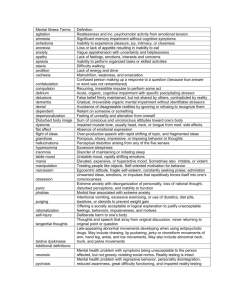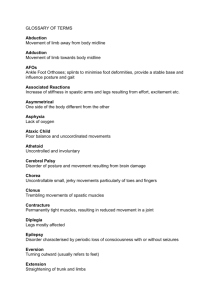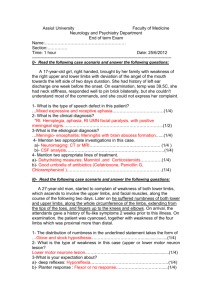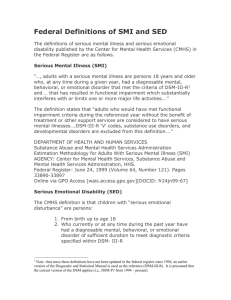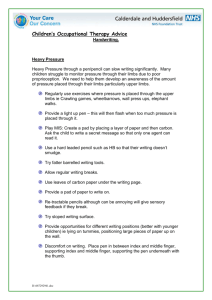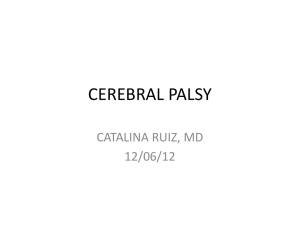Handout 6 - Porterville College
advertisement
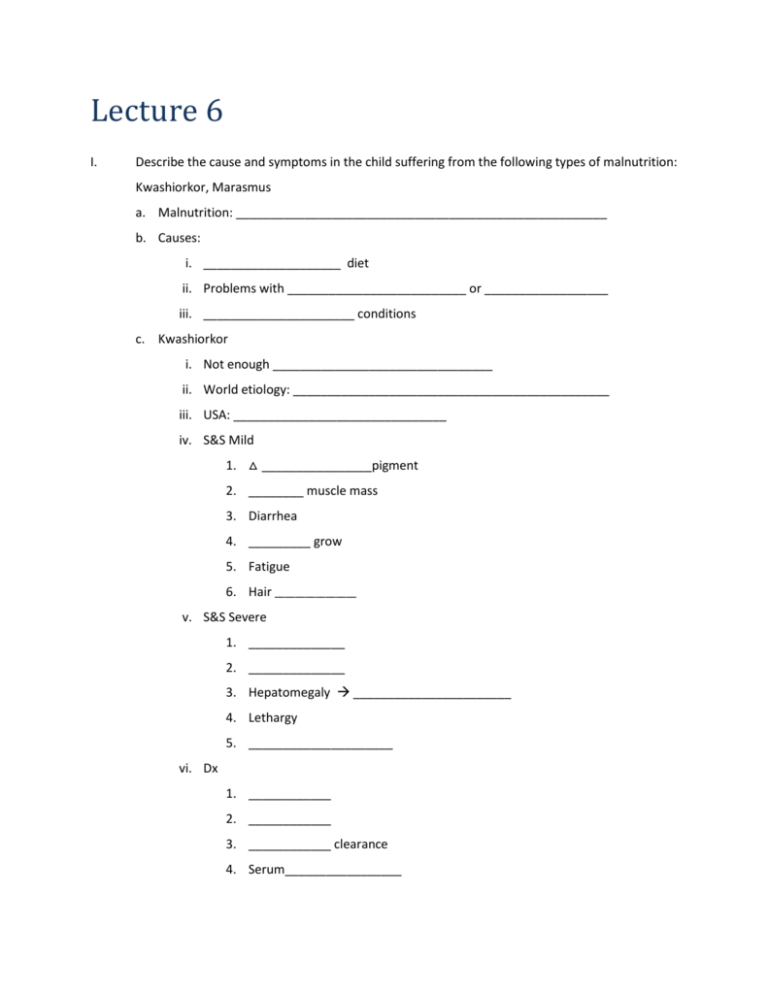
Lecture 6 I. Describe the cause and symptoms in the child suffering from the following types of malnutrition: Kwashiorkor, Marasmus a. Malnutrition: ______________________________________________________ b. Causes: i. ____________________ diet ii. Problems with __________________________ or __________________ iii. ______________________ conditions c. Kwashiorkor i. Not enough ________________________________ ii. World etiology: ______________________________________________ iii. USA: _______________________________ iv. S&S Mild 1. △ ________________pigment 2. ________ muscle mass 3. Diarrhea 4. _________ grow 5. Fatigue 6. Hair ________________ v. S&S Severe 1. ______________ 2. ______________ 3. Hepatomegaly _______________________ 4. Lethargy 5. _____________________ vi. Dx 1. ____________ 2. ____________ 3. ____________ clearance 4. Serum_________________ 5. Serum________________________________ 6. Total _______________________ vii. Treatment 1. __________ _____________________ a. 1st: ______________ 2nd ______________ viii. Prevention: ___________ 1. ______________________ 2. ______________________ 3. ______________________ d. Marasmus i. Overall ___________________________ ii. ____________________ wasting & Stunted ____________________ iii. Treatment 1. __________________________________ e. Ricketts i. Deficiency of _________________________________ ii. S&S: ___________________ deformities iii. Treatment: 1. _____________________ 2. _____________________ f. Pellagra i. ________________________ (________________________ vitamin) ii. S&S 1. Scaly ________________________ 2. Inflamed _____________________ 3. __________________ disturbances iii. Treatment 1. _____________________________________ II. Differentiate between the following forms of cerebral palsy: Spastic, Dyskinetic, Ataxic, Mixed a. General i. Disorder of ___________________________________________________ ii. Results from a non-_____________________ lesion in the _____________ 1. __________________impairments, 2. ___________________ 3. ___________________ loss iii. _______ in neonatal care _______________ of very low birth weight babies iv. most often attributed to _________________________injury 1. _______________________________ 2. Exposure to ____________________________ 3. Maternal-fetal blood ___________________________________ 4. Faulty ________________________ of ovum v. Perinatal 1. ___________________________ 2. ___________________________ bleeding vi. Postnatal 1. ______________________ 2. Brain _____________________________ 3. _________________________________ 4. _________________________________ vii. Classifications 1. Spastic* a. ____________________ b. Lesion located __________________________________ c. -“_________________” i. movement is______________ , _______________, _____________________in range ii. occasionally _____________ and __________________ d. Further sub-typed by limbs affected: i. -all four limbs = _______________________ ii. -two like limbs, mostly legs = ____________________ iii. -three limbs = ________________________ iv. -legs only = ________________________ v. -limbs on one side only = _____________________ vi. -one limb = _______________________ e. Classification by severity i. Mild: May lack only _____________motor movements, have awkward______________, arms out for ________________ ii. Moderate: problems with ___________and __________motor and ___________________ iii. Severe: unable to____________, use____________, or speak 2. Dyskinetic a. AKA: __________________________________ b. Refers to one of the two ________________ tracts in the brain that control movement c. impairment in muscle ____________ and a variety of abnormal motor ______________ and __________________ i. ______________________and without purpose ii. Disappear with _____________________ iii. Increase with _______________________ d. Types of Movement i. (#1) _____________________ 1. slow, _______________, __________________ 2. If movements are ______________:choreic or ii. ____________________ 1. Movement is ______________________ 2. _____________________________ iii. _________________________ 1. ________________ & __________________like 3. Ataxic a. disorder of __________________/ ______________________ b. lesion is in the _______________________________ c. S&S i. Gait 1. ___________________________________ 2. ___________________________________ ii. -hand movements ________________with tendency to under or over ___________________ iii. -difficulty with _______________finger movements or _____________________turning 4. Atonic (______________________) a. Usually ________________at birth and persists beyond ______ b. usually develops__________________, ataxia, difficulty with ____________________movements c. -cognitive impairment __________________________________ d. -can also develop into _________________________form by age 3 5. Mixed a. combination of _________________________disorders b. -most common mix is _________________ & _____________ c. less common is _________________ & __________________ 6. Associated Disorders a. _______________________ impairment b. _______________________ impairment i. Most affected: ______________________________ ii. Least affected: ______________________________ c. _______________________ disorders i. _____________ ___________________ _____________ ii. __________________ d. Health Problems i. ____________________ ii. ____________________ deformities iii. ____________________ iv. ____________________difficulty v. ______________ abnormalities vi. ______________ loss 7. Treatment a. ___________________ therapy b. ___________________ i. _________________ injections c. ___________________ not usually helpful d. ___________________ devices e. Supported __________________________ & _______________ III. Explain the prevalence of seizure disorders in the DD population.
